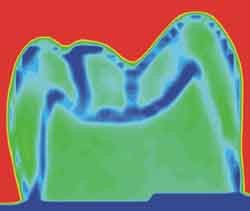T-ray Triumph
X rays may be as familiar as your local dentist’s office or airport security checkpoint, but it’s unlikely that you’ve ever encountered a powerful T-ray. This long-wavelength infrared light could be used for a host of possible applications, but until recently, it’s been impossible to generate strong enough beams. Last year researchers used a linear accelerator to generate the most powerful T-ray beam ever made. Now, in the 7 March print issue of PRL, a team describes a way to produce a more stable and useful beam. They modified an electron storage ring–a facility for producing powerful x rays–to produce high-power T-rays. The results prove that a planned, dedicated T-ray facility in the US is realistic.
T-rays–beams of terahertz radiation–are useful because they can penetrate many materials, including living cells, without damaging them. At the same time, they provide a spectrum that’s highly sensitive to the material’s composition. The possible applications for T-rays range from basic research, such as studying the properties of superconductors, to medical imaging, and even security. One British company has already developed a way to use T-rays to image skin cancer, and some researchers envision using it to screen for biological and chemical weapons. But while LED’s, lasers, and vacuum tubes can create powerful beams at higher and lower frequencies, there’s no easy source for high-power terahertz radiation.
Last year, a team at the Thomas Jefferson National Accelerator Facility in Virginia found a way to fill this “terahertz gap,” using a linear accelerator to produce a 20-watt T-ray beam [1]. Now researchers at the BESSY synchrotron radiation facility in Berlin, Germany, have used a similar technique and obtained a higher quality beam.
At a synchrotron radiation source, electrons emit radiation as they are guided by magnets around a storage ring. Synchrotron facilities are optimized to emit powerful x rays, which have a variety of uses in research, but they also emit weak T-rays. The T-rays are weak because, explains researcher Gode Wüstefeld of BESSY, the electrons racing around a storage ring travel in discrete bunches that are about five millimeters long. Because the wavelength of terahertz radiation is less than one millimeter, the billion or so electrons in each bunch emit their radiation out of phase–the waves cancel each other out, and the total T-ray power is low.
In their new study, the BESSY team demonstrated that by adjusting the strength of some of the magnets in the storage ring, they could reduce the bunch length to about one millimeter. The electrons in each bunch then act as one giant “macro-particle” and emit coherent T-rays–a laser-like beam of far infrared light. “This sounds very simple,” says Wüstefeld. “But when we do this, we must do a lot of corrections, because the machine will not digest these changes.”
In the Jefferson Lab’s linear accelerator, a different, newly-produced bunch of electrons generates each terahertz radiation pulse. In an electron storage ring, where the same electron bunches circulate over and over, the beam is more stable and has a higher signal-to-noise ratio.
Researchers at the Lawrence Berkeley National Laboratory (LBNL) in California are particularly pleased to see these results. They recently proposed building a dedicated T-ray electron storage ring at their lab. “We’d been proposing this new source before the BESSY results, but we were proposing it based on a phenomenon that had never been observed,” says LBNL’s John Byrd. “We knew it should be there, but nobody had observed it. So it was very reassuring to us that they’ve observed it at BESSY.”
–Lea Winerman
Lea Winerman is a freelance science writer.
References
- G.L. Carr et al., Nature (London) 420, 153 (2002)



